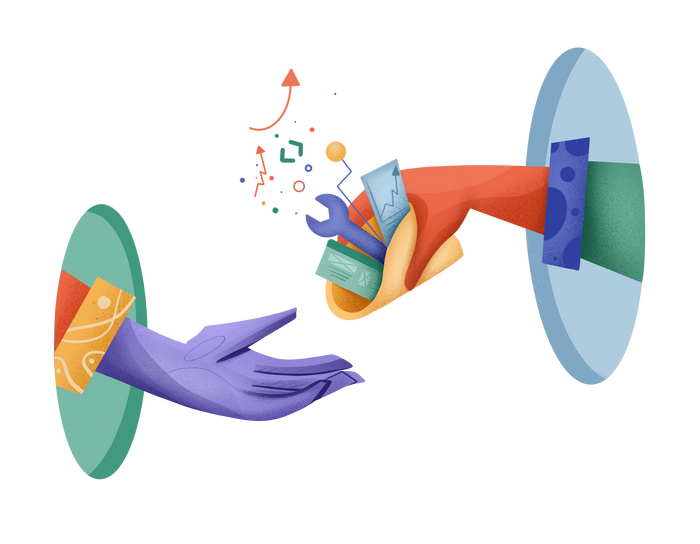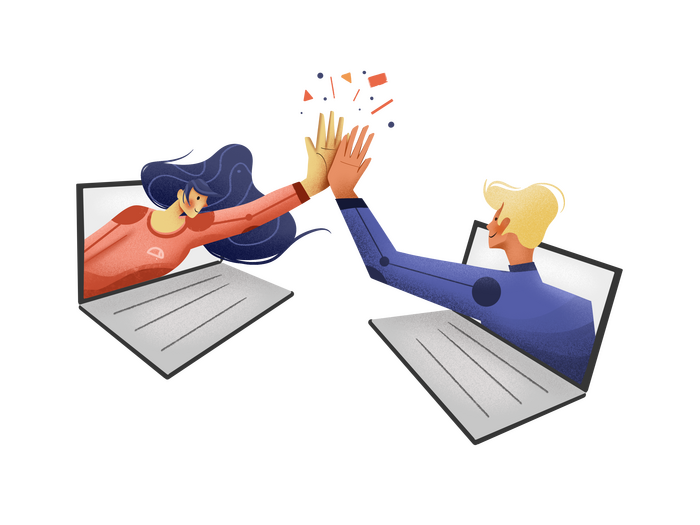It’s fair to say that automation in the workplace has completely revolutionized the way we work.
No matter your industry or role, you’re bound to have seen automation and artificial intelligence disrupting (or enhancing!) your work life to some degree. Automated tools are everywhere, from lipstick shade matching to customer service.
While this article won’t help you find the perfect lipstick, we can show you a thing or two about how to use automation to amp up your e-commerce business.
Can Small Businesses Use Automation?
There’s a common misconception that automation is only accessible to giant global companies with huge tech budgets, but we beg to differ. There are plenty of unique, realistic ways to work with automated tools--and even artificial intelligence--in your own team, regardless of scale.
One of the best ways to get started with automation is to install a chatbot on your website.

What Is a Chatbot and How Is It Used?
A chatbot is an automated tool most often used in a support capacity. Remember phone support? Sitting on hold for 30 minutes waiting for someone to answer a simple question, forced to listen to the scratchy jazz music? No more! Chatbots can quickly and efficiently analyze requests and pull answers from an ever-growing answer repository, streamlining and enhancing the customer experience.
Beyond their ability to supply information, chatbots help to personify a company’s digital presence by simulating warm, helpful human interaction. As artificial intelligence quality increases, these computer brains will excel further at understanding human speech (er, text?) patterns. The more we teach the technology, the more human the robots will become—kind of creepy, but effective.
Not all chatbots are created equal. They vary in quality, purpose, and effect, and there are a few factors to consider before deciding which one is right for your Shopify store. Our goal is to help you understand how to select, implement, and optimize your new robofriend.
What Types of Chatbots are There?
As with most digital tools, chatbots come in a variety of flavors. The three types below demonstrate a common progression for companies venturing into the world of chatbots.

Button-Based Bot
Button-based chatbots are simple yet effective. Inquiring site visitors are offered a selection of predesignated questions to choose from. Upon pressing the relevant button, the chatbot spits out the pre-programmed answer to that specific question. It’s simple, straightforward, and quick to get started, but somewhat limited.
Hybrid Bot
Hybrid bots supply pre-made answers just like button bots, but they offer more flexibility to the customer, who can type in their own unique questions. Not only does this widen the keyword net for the customer (giving them a higher chance of getting the answer they’re looking for), but it allows the company to learn what issues their customers are having.
AI-Specific Bot
These advanced chatbots are powered by artificial intelligence. They are not rule-based, which means they are not beholden to a predetermined set of question-and-answer parameters. They can be trained to understand the intention behind a customer’s inquiry instead of just processing the words, which means they can provide incredibly personable, rich answers.
Which Chatbot is Right for Me?
We talk about button, hybrid, and AI bots sequentially because companies often begin with a button-based bot to get the feel of automated support, inexpensively. If it meets their needs, they can play with more advanced versions until they’re ready for a full AI solution (if necessary).
You’ll know it may be time to move on to a hybrid bot once you’ve proven it works and learned a bit about your customers’ inquiry patterns. Hybrids are more affordable than sophisticated artificial intelligence bots and, if implemented correctly, provide a sense of customization (read: humanity) for the customer. This flexibility eliminates the predetermination hurdle present in the button-based model, allowing merchants to understand better what their customers want to know.
You might consider graduating to an AI bot if your Shopify store receives hundreds of inquiries per day, your support staff is limited, and/or customers are becoming disgruntled by long wait times.
Before you go charging out, though, remember one thing: AI bots work best when they’ve effectively adapted to your customers’ needs. As such, they take time and strategy to train, which can make them a relatively expensive solution. What’s more, during this “training” period, AI bots will provide more unpredictable customer service than their rule-based cousins, so it’s best to have a specialist on deck to help out with hiccups.

This is by no means an all-inclusive list. Proper chatbots and AI solutions abound for every industry and need. Be sure to do your research and know what you’re trying to achieve. Do you just want an interactive FAQ experience, or do you need your bot to comb through sprawling, complicated datasets to gather information from a variety of channels? Define your needs, then look for the answer.
We’ll expand on this in the next section, but if your head is spinning and you just. want. help: we know a guy.
How To Optimize a Chatbot for Your Website
Give It a (Specific) Purpose
Having a strong, specific set of goals for your chatbot will help you get started on the right foot. How will your audience benefit from the bot? What can it offer them? Establish this as specifically as possible and work from there.
What do we mean by specific?
🚫I want a chatbot for customer service.
Not specific. Why do you need help with customer service? Which aspects of customer service are suffering? What is your actual problem? Response time? Accuracy? Agent retention? Payroll?
If implemented, how are you going to measure the success of your bot?
✅My customer service expenditure is high, and most of the questions the agents are asked are simple and repetitive.
This is a clearly defined problem that a chatbot could solve. How?
I have a large repository of answers to commonly asked questions and want a rule-based chatbot that will help at least 80% of my customers find answers without needing to reach out to our support team. I also want to reduce spend on live customer service agents by 20% in the next six months.
This is specific, measurable, and possible.
Give It a Face
Humanizing your chatbot can create a friendly, conversational customer service experience. A personified chatbot better simulates human interaction, which makes customers feel a more personal connection. You never want your customers to feel like you’ve assigned some nameless, faceless robot to deal with their questions.
Think of your chatbot like a digital receptionist. Give him or her a name and a profile picture or avatar. What kind of first impression do you want to make?
Take It for a Test Drive...or Twelve

Even in our progressive technological climate, there will be challenges when you try to make a robot do a human’s job. The easiest way to mitigate issues? Test, test, and test again.
Perhaps the most common chatbot gripe is rooted in their inability to accurately interpret and resolve questions, resulting in repetitive and/or unhelpful answers. Sometimes, particularly with AI and hybrid bots, this is unavoidable.
However, much of the beauty of artificial intelligence lies in its ability to learn and improve over time. You can enhance your bot’s intuition by testing all available question paths. It can be tedious, but it ensures that your bot is consistently putting out useful answers. We’d recommend doing this frequently, especially if the content on your website changes often.
Give the People What They Want
The user experience is vital when it comes to optimizing a chatbot. Minor details like the ease of refreshing a chat or visual appeal can make all the difference.
If there’s a way to get impartial feedback on your chatbot, ask for it! Include a very simple post-chat rating system to capture a sentiment in the moment. Anonymous customer surveys are another good place to start.
Should My Shopify Store Really Get a Chatbot?
The demand for 24/7 customer service can be overwhelming, and chatbots are one of the best ways to mitigate this challenge. Data says chatbots are only going to get more popular. The market value is expected to skyrocket to $9.4B by 2024. (Source)
It’s clear that well-groomed chatbots and AI solutions can benefit both company and customer, but with so many options and varying goals, it can be tough to know where to start. However, it is possible to find an assistant that works for you if you keep the following in mind:
- Establish clear, measurable goals for your chatbot. What specific problems do you need a chatbot to solve? What capabilities must it have to do so, and what metrics will indicate success? This will help you decide which type of chatbot might work best for you.
- Do you have the resources to roll out a chatbot effectively? A janky, untrained chatbot is worse than none at all. Make sure you have the budget and time (or people) to dedicate to building a well-oiled machine. (That includes getting it up and running and conducting ongoing diagnostics to find opportunities for improvement.)
- What do your customers want? What questions are they asking, and what complaints have you received about other support-related areas of your company? Use that information to guide the setup of your bot.
- Does your chatbot’s aesthetic, welcome message, and general language accurately represent your brand?

















